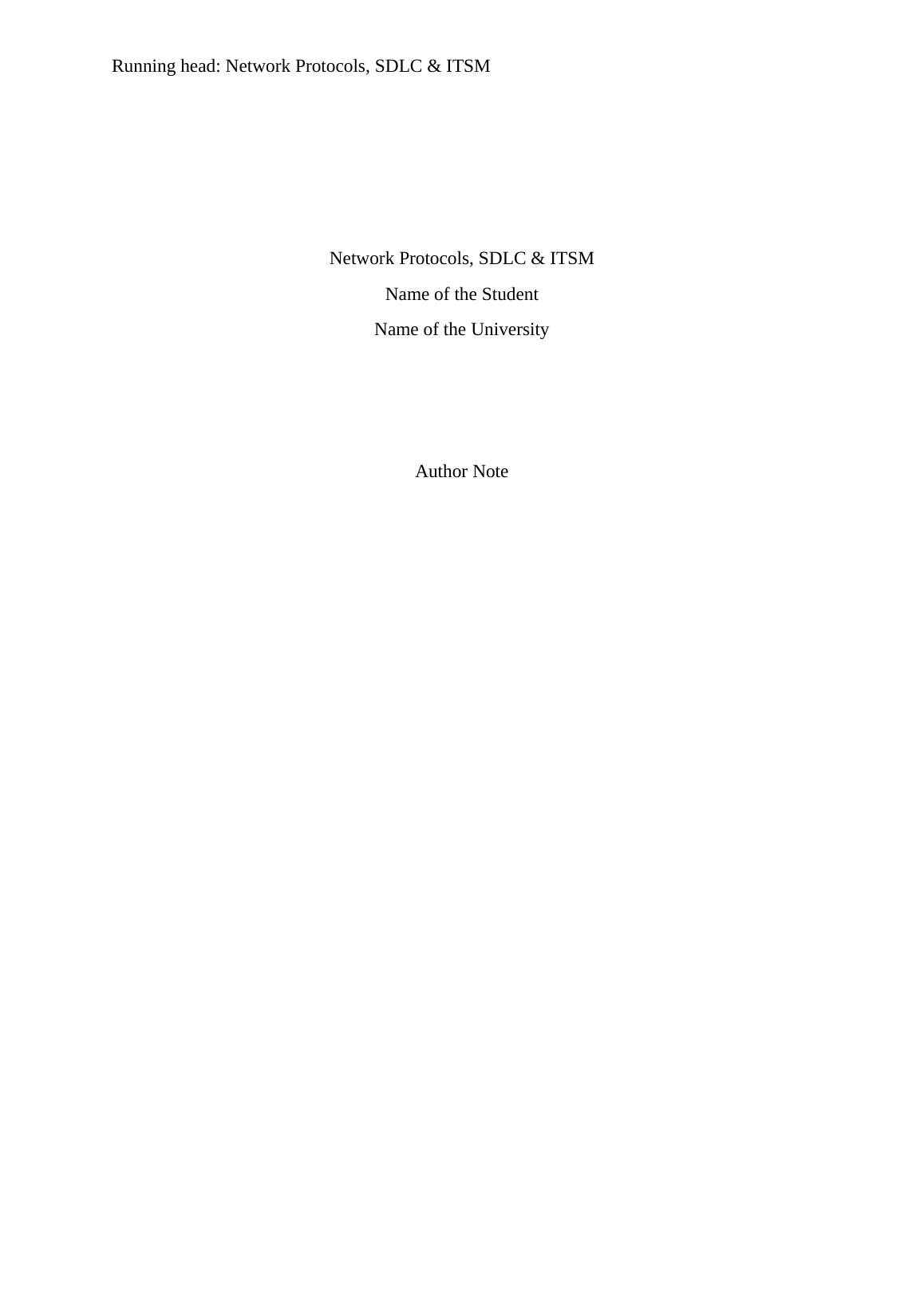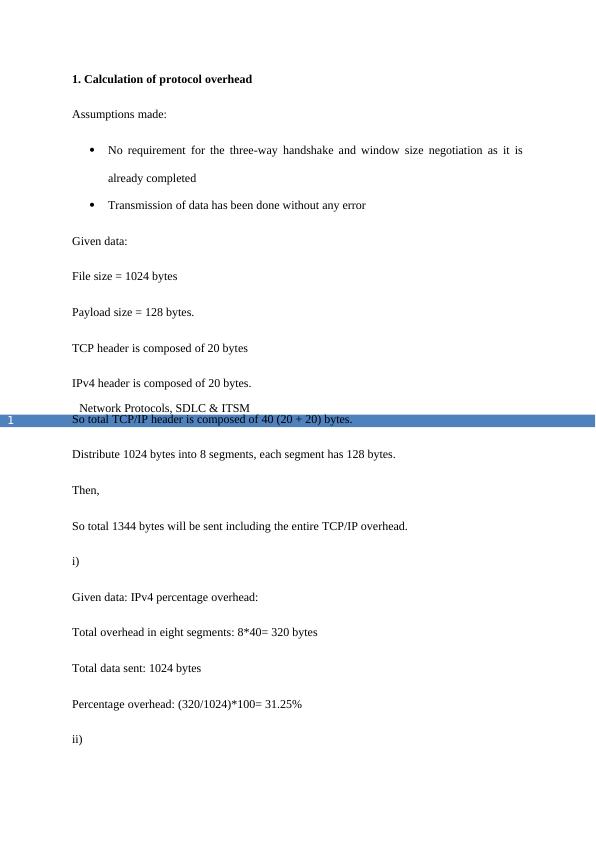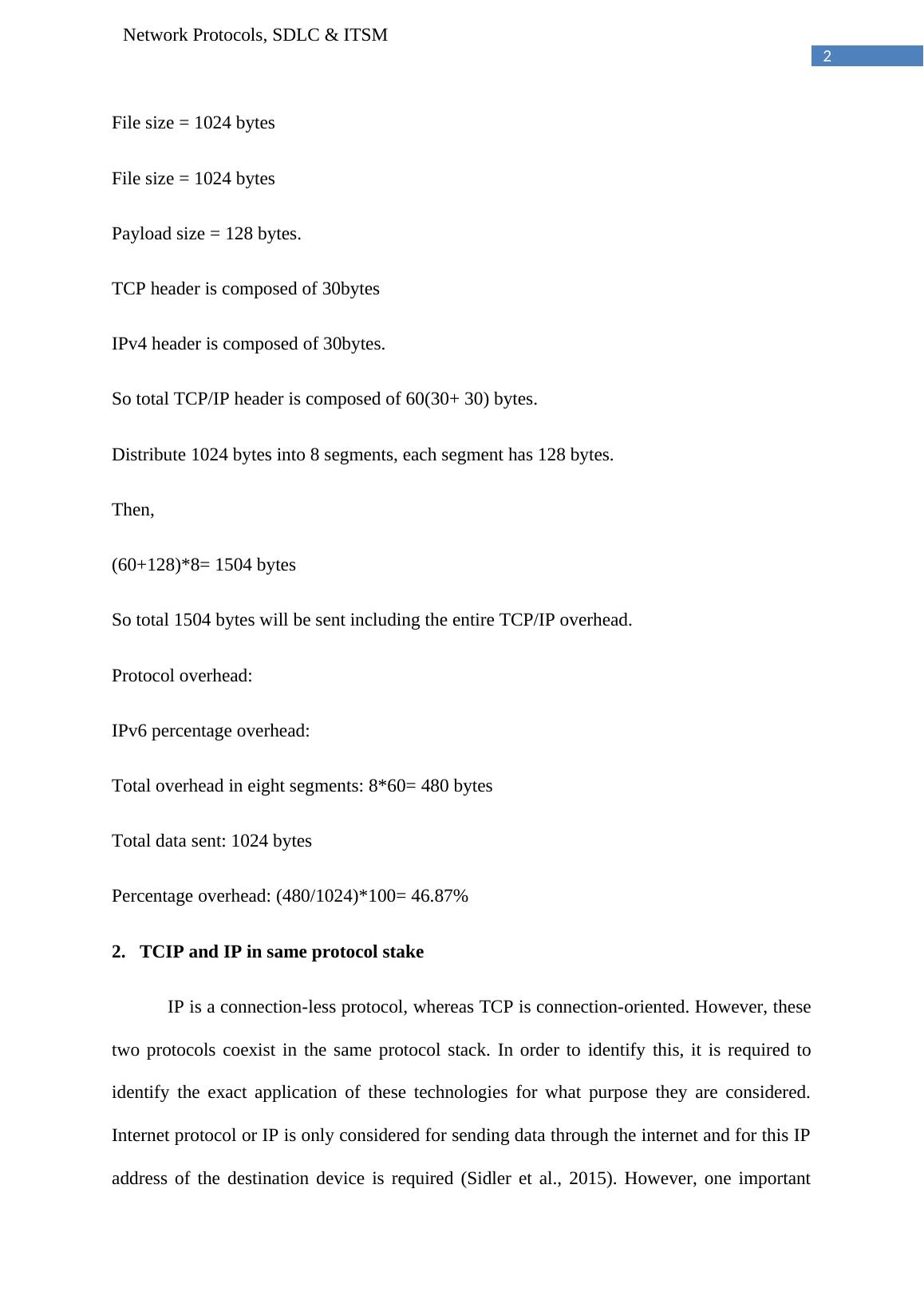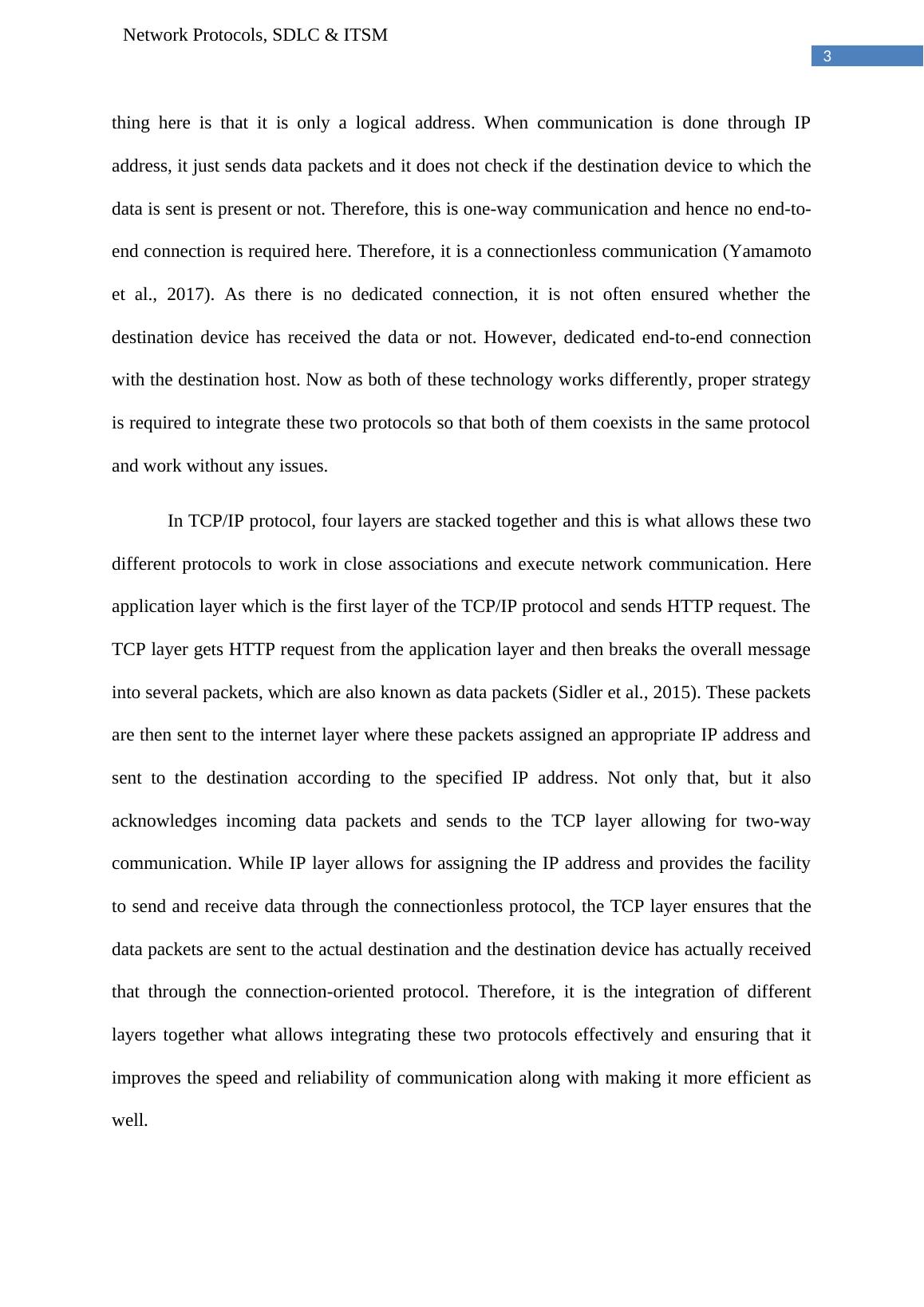Network Protocols, SDLC & ITSM
Added on 2022-11-14
14 Pages3637 Words342 Views
Running head: Network Protocols, SDLC & ITSM
Network Protocols, SDLC & ITSM
Name of the Student
Name of the University
Author Note
Network Protocols, SDLC & ITSM
Name of the Student
Name of the University
Author Note

Network Protocols, SDLC & ITSM
1
1. Calculation of protocol overhead
Assumptions made:
No requirement for the three-way handshake and window size negotiation as it is
already completed
Transmission of data has been done without any error
Given data:
File size = 1024 bytes
Payload size = 128 bytes.
TCP header is composed of 20 bytes
IPv4 header is composed of 20 bytes.
So total TCP/IP header is composed of 40 (20 + 20) bytes.
Distribute 1024 bytes into 8 segments, each segment has 128 bytes.
Then,
So total 1344 bytes will be sent including the entire TCP/IP overhead.
i)
Given data: IPv4 percentage overhead:
Total overhead in eight segments: 8*40= 320 bytes
Total data sent: 1024 bytes
Percentage overhead: (320/1024)*100= 31.25%
ii)
1
1. Calculation of protocol overhead
Assumptions made:
No requirement for the three-way handshake and window size negotiation as it is
already completed
Transmission of data has been done without any error
Given data:
File size = 1024 bytes
Payload size = 128 bytes.
TCP header is composed of 20 bytes
IPv4 header is composed of 20 bytes.
So total TCP/IP header is composed of 40 (20 + 20) bytes.
Distribute 1024 bytes into 8 segments, each segment has 128 bytes.
Then,
So total 1344 bytes will be sent including the entire TCP/IP overhead.
i)
Given data: IPv4 percentage overhead:
Total overhead in eight segments: 8*40= 320 bytes
Total data sent: 1024 bytes
Percentage overhead: (320/1024)*100= 31.25%
ii)

Network Protocols, SDLC & ITSM
2
File size = 1024 bytes
File size = 1024 bytes
Payload size = 128 bytes.
TCP header is composed of 30bytes
IPv4 header is composed of 30bytes.
So total TCP/IP header is composed of 60(30+ 30) bytes.
Distribute 1024 bytes into 8 segments, each segment has 128 bytes.
Then,
(60+128)*8= 1504 bytes
So total 1504 bytes will be sent including the entire TCP/IP overhead.
Protocol overhead:
IPv6 percentage overhead:
Total overhead in eight segments: 8*60= 480 bytes
Total data sent: 1024 bytes
Percentage overhead: (480/1024)*100= 46.87%
2. TCIP and IP in same protocol stake
IP is a connection-less protocol, whereas TCP is connection-oriented. However, these
two protocols coexist in the same protocol stack. In order to identify this, it is required to
identify the exact application of these technologies for what purpose they are considered.
Internet protocol or IP is only considered for sending data through the internet and for this IP
address of the destination device is required (Sidler et al., 2015). However, one important
2
File size = 1024 bytes
File size = 1024 bytes
Payload size = 128 bytes.
TCP header is composed of 30bytes
IPv4 header is composed of 30bytes.
So total TCP/IP header is composed of 60(30+ 30) bytes.
Distribute 1024 bytes into 8 segments, each segment has 128 bytes.
Then,
(60+128)*8= 1504 bytes
So total 1504 bytes will be sent including the entire TCP/IP overhead.
Protocol overhead:
IPv6 percentage overhead:
Total overhead in eight segments: 8*60= 480 bytes
Total data sent: 1024 bytes
Percentage overhead: (480/1024)*100= 46.87%
2. TCIP and IP in same protocol stake
IP is a connection-less protocol, whereas TCP is connection-oriented. However, these
two protocols coexist in the same protocol stack. In order to identify this, it is required to
identify the exact application of these technologies for what purpose they are considered.
Internet protocol or IP is only considered for sending data through the internet and for this IP
address of the destination device is required (Sidler et al., 2015). However, one important

Network Protocols, SDLC & ITSM
3
thing here is that it is only a logical address. When communication is done through IP
address, it just sends data packets and it does not check if the destination device to which the
data is sent is present or not. Therefore, this is one-way communication and hence no end-to-
end connection is required here. Therefore, it is a connectionless communication (Yamamoto
et al., 2017). As there is no dedicated connection, it is not often ensured whether the
destination device has received the data or not. However, dedicated end-to-end connection
with the destination host. Now as both of these technology works differently, proper strategy
is required to integrate these two protocols so that both of them coexists in the same protocol
and work without any issues.
In TCP/IP protocol, four layers are stacked together and this is what allows these two
different protocols to work in close associations and execute network communication. Here
application layer which is the first layer of the TCP/IP protocol and sends HTTP request. The
TCP layer gets HTTP request from the application layer and then breaks the overall message
into several packets, which are also known as data packets (Sidler et al., 2015). These packets
are then sent to the internet layer where these packets assigned an appropriate IP address and
sent to the destination according to the specified IP address. Not only that, but it also
acknowledges incoming data packets and sends to the TCP layer allowing for two-way
communication. While IP layer allows for assigning the IP address and provides the facility
to send and receive data through the connectionless protocol, the TCP layer ensures that the
data packets are sent to the actual destination and the destination device has actually received
that through the connection-oriented protocol. Therefore, it is the integration of different
layers together what allows integrating these two protocols effectively and ensuring that it
improves the speed and reliability of communication along with making it more efficient as
well.
3
thing here is that it is only a logical address. When communication is done through IP
address, it just sends data packets and it does not check if the destination device to which the
data is sent is present or not. Therefore, this is one-way communication and hence no end-to-
end connection is required here. Therefore, it is a connectionless communication (Yamamoto
et al., 2017). As there is no dedicated connection, it is not often ensured whether the
destination device has received the data or not. However, dedicated end-to-end connection
with the destination host. Now as both of these technology works differently, proper strategy
is required to integrate these two protocols so that both of them coexists in the same protocol
and work without any issues.
In TCP/IP protocol, four layers are stacked together and this is what allows these two
different protocols to work in close associations and execute network communication. Here
application layer which is the first layer of the TCP/IP protocol and sends HTTP request. The
TCP layer gets HTTP request from the application layer and then breaks the overall message
into several packets, which are also known as data packets (Sidler et al., 2015). These packets
are then sent to the internet layer where these packets assigned an appropriate IP address and
sent to the destination according to the specified IP address. Not only that, but it also
acknowledges incoming data packets and sends to the TCP layer allowing for two-way
communication. While IP layer allows for assigning the IP address and provides the facility
to send and receive data through the connectionless protocol, the TCP layer ensures that the
data packets are sent to the actual destination and the destination device has actually received
that through the connection-oriented protocol. Therefore, it is the integration of different
layers together what allows integrating these two protocols effectively and ensuring that it
improves the speed and reliability of communication along with making it more efficient as
well.

End of preview
Want to access all the pages? Upload your documents or become a member.
Related Documents
Network Protocols, SDLC & ITSM.lg...
|9
|1764
|2
TCP/IP Model, Software Development Process and ITSMlg...
|8
|1638
|454
IT Fundamental - TCP/IP Header, Agile Method, Apple Design Processlg...
|7
|1298
|268
TCP/IP Model, Software Development Process and ITSMlg...
|8
|1316
|229
Network Protocols, SDLC & ITSMlg...
|7
|1244
|424
Fundamental of ITlg...
|8
|1354
|314
